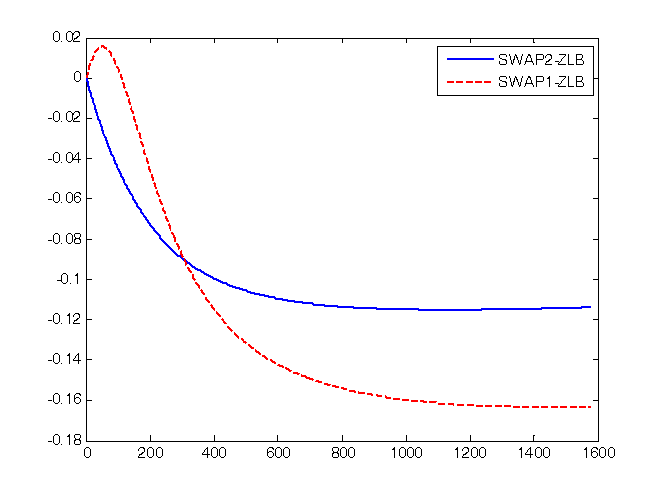Some Federal Reserve officials apparently have a rule of thumb for thinking about the impact of the Fed’s large-scale asset purchases. I was curious to compare those estimates with the numbers that would come out of my own research.
When principal is repaid on assets currently held by the Federal Reserve, reserve deposits of the payer’s account with the Fed are debited. The result is that the Fed’s balance sheet contracts: both the Fed’s assets (its security holdings) and its liabilities (reserve deposits) decline whenever assets mature. Brian Sack, Executive Vice President of the Federal Reserve Bank of New York, offered this assessment on Wednesday of what it would mean if the Fed were to decide from here on to let the assets it currently holds mature without rolling them over:
If all asset classes in the SOMA were allowed to run off, the portfolio would decline by about $250 billion per year on average over the first several years. Under the interpretation of the policy stance noted earlier, this shrinkage of the balance sheet would amount to a tightening of policy. However, one should realize that this step represents a relatively gradual and limited policy tightening. Indeed, using the mapping that has been discussed by Chairman Bernanke, this path for the balance sheet would, in terms of its effects on the economy, be roughly equivalent to raising the federal funds rate by just over 25 basis point per year over the course of several years.
Sack’s proposed rule of thumb seems to be that each $100 billion decrease in the Fed’s holdings of long-term securities would roughly correspond to what in normal times we’d measure with a 10 basis point increase in the fed funds rate.
I was curious to take a look at what kind of number for this calculation would emerge from my own research. In my research with Cynthia Wu, we estimated that if the Fed were to buy $400 billion of the longest-maturity Treasuries available, it might lower the 10-year yield by about 13 basis points. However, as I noted last December, instead of buying the longest-term securities, instead the Fed has actually been purchasing intermediate-term bonds. In our framework, we estimate that $400 billion in such purchases would only move the 10-year yield by about 10 basis points, or 2.5 basis points for each $100 billion.
 |
The next question is how to relate this change in the 10-year rate to the Fed’s traditional target of the overnight yield. One way to do this is to look at what the relation used to be between changes in the 10-year yield and changes in market expectations about the near-term fed funds rate. In analysis of data over 1988-2006, I found that a one-basis-point increase in the expected fed funds rate was associated with about a 0.4-basis-point increase in the 10-year yield (see Table 2 of Hamilton (2008)). Using that ratio, a $100 billion decrease in the Fed’s assets would roughly correspond to a 6 basis point increase in the fed funds rate, somewhat smaller than the 10 bp rule of thumb invoked by Sack above.
 |
Granted, Cynthia’s and my estimates of the effects of LSAP are somewhat smaller than those obtained by other researchers, and any of these estimates are subject to considerable uncertainty. But these calculations illustrate that the Fed’s rule of thumb could easily be off by a factor of two.
JDH Would the potential appreciation of other Fed assets (e.g., mortgage backed securities) have comparable effects on 10 year Treasury bonds? Presumably the Fed will be holding onto those for quite awhile. Now suppose the economy improves in a few years and alternative Fed assets begin to appreciate along with the economy. Could the appreciating value of those assets put some downward pressure on the price of Treasury bonds?
2slugbaits: I don’t believe that appreciation or depreciation of the assets held by the Fed has any significant effect in itself. The primary effects I am talking about here have to do with changing the supplies of different assets held by the public, and appreciation has no effect on that. Of course, general changes in interest rates are significant in their own right, independent of any consequences for the Fed’s balance sheet.
JDH Okay, thanks. Does this mean that the Fed is at least weakly committed to keeping its unconventional assets off the market whenever the Fed gets around to unwinding QE1 and QE2? I wasn’t clear, but that’s really the kind of thing that I was getting at when I asked about appreciating value.
Has anyone ever considered the possibility that the policy of lowering interest rates is the cause of, not the solution to, the current lack of growth?
Low interest rates may look good from the borrower’s point of view, but not at all good from the lender’s point of view.
http://www.philipji.com/item/2011-07-24/why-banks-do-not-lend-at-near-zero-interest-rates
2slugbaits: The effect on asset prices (and thus on interest rates) of the Fed selling off some of its portfolio is exactly what we’re discussing here. My estimate is that each $100 B sold might raise the 10-year Treasury yield by 6 basis points. I have not separately estimated an effect of MBS sales but in the paper with Cynthia we review evidence suggesting it should be a similar effect. In our framework, a sale is the same as accepting payment for the asset upon maturity.
George, low interest rates encourage wasteful spending and don’t benefit people who are already leveraged. Basically the fed is financing institutional arbitrage, cheap fed money to borrow to lend to the inept, but reliable treasury.